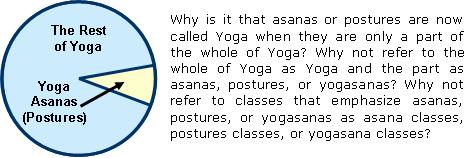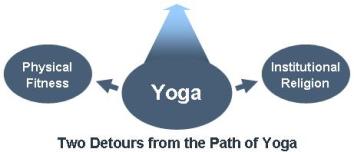With all the names and modern styles of yoga the question arises: What kind of Yoga do you do?
All the recent “inventions” just confuse matters more. The essential, authentic nature of yoga is even further confused in the public eye by the way the methods are presented and promoted. By reviewing almost any list of the best known dozen or so modern yoga "styles," it will quickly become evident that almost all of these contemporary styles have been invented in the last few decades. Very few yoga teachers today will simply teach "Hatha Yoga," the physical yoga system of the past (that actually had spiritual goals), let alone the “whole” true spiritual yoga. Remember that even Hatha Yoga (asana + pranayama) is part of the eight limbs of Raja Yoga and Raja Yoga is only one of the four traditional schools of yoga.
In addition, many, if not most of the modern "styles" of yoga have the surname of a currently living man in front of the word yoga, as if that man, himself, has invented yoga. This is not to say that these teachers aren’t competent or even superb in their physical abilities. They may do a very good job within the limited scope of their “personalized” teachings.
Oftentimes this “personalization” takes the liberty of distorting Sanskrit terms. Several modern systems have taken an ancient Sanskrit word or phrase that has a specific spiritual meaning, and then adapted that terminology to some set of postures or practices that were apart from the original intent.
Even worse, some of these modern teachers have then trademarked these ancient, traditional names, further misleading an unsuspecting public. This leaves the would-be students with the impression that the current day founder of this “brand name” system is somehow linked to the original teachings associated with that word or phrase. It may further lead people to believe that these new teachers also have some expertise or familiarity with the traditional practice or level of attainment authentically associated with that word or phrase.
Most of the modern "styles" of Yoga did not exist a few decades ago, while yoga itself is thousands of years old.
These modern styles are very suspect as they should be. If you turned back the clock a hundred years, or maybe fifty, or twenty, or even less, very few (if any at all) of these current styles, systems, or methods of yoga would have yet existed. Most of the founders of these modern, so-called yoga styles were not even born. Therefore, these modern styles are, by their very nature, suspect. Especially when, at the same time, it is claimed that yoga is thousands of years old. This is not a mere call to go back in time to some theoretically more pristine era of yoga. It really is a case of throwing away the baby with the bath water.
To repeat the question at the beginning of this article: What kind of yoga do you do?
Traditionally, there are four schools of Yoga. If asked, "What kind of Yoga do you do?" the answer would be one of these four, or a combination of them. Briefly, the four schools of Yoga are:
-
Karma Yoga: The yoga of action, doing the practices while fulfilling one's duties in the external world.
-
Jnana Yoga: The yoga of knowledge or self-enquiry, knowing oneself at all levels through a process of contemplation and introspection.
-
Bhakti Yoga: The yoga of devotion, of surrender to the divine force or God, practiced in ways consistent with one's own religion.
-
Raja Yoga: The meditative school of yoga, such as systematized by Patanjali in the Yoga Sutras.

Additionally, it is important to note that yoga itself has been classically considered to be one of "six schools of Indian philosophy."
A true Yogi, one who sincerely practices authentic Yoga, may do just yoga, meaning some combination of Karma, Jnana, Bhakti, and Raja Yoga, in the context of the six systems of Indian philosophy and practice.
Paramahansa Yogananda, the well-known author of Autobiography of a Yogi, responds to the question "What is Yoga?" in the text The Essence of Self-Realization: "Yoga means union.” Yoga is loosely translated as the English word “yoke.” Yoga means union with God, or, union of the little, ego-self with the divine Self, the infinite Spirit. Most people in the West, and sadly many in India, confuse yoga with Hatha Yoga, the system of physical practice.
Stay tuned, this series will continue – coming up next, the final installment in this series; “Approaches to the True Goal of Yoga (Part 16).” This next blog article will include some final thoughts and tips.
Rae Indigo is ERYT 500








